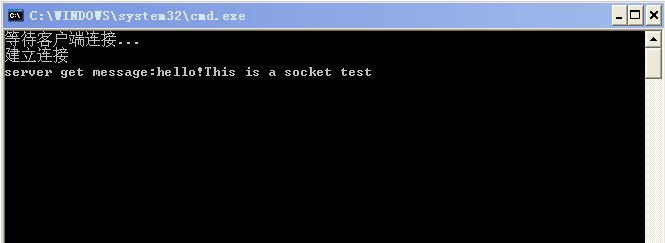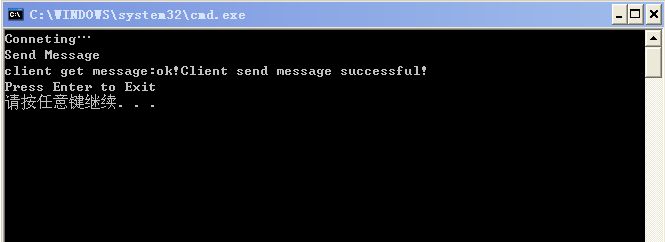c#中的socket编程基础
最基本的C# socket编程
示例程序是同步套接字程序,功能很简单,只是客户端发给服务器一条信息,服务器向客户端返回一条信息;这里只是一个简单的示例,是一个最基本的socket编程流程,在接下来的文章中,会依次记录套接字的同步和异步,以及它们的区别。
下面是示例程序的简单步骤说明
服务器端:
第一步:用指定的端口号和服务器的ip建立一个EndPoint对像;
第二步:建立一个Socket对像;
第三步:用socket对像的Bind()方法绑定EndPoint;
第四步:用socket对像的Listen()方法开始监听;
第五步:接受到客户端的连接,用socket对像的Accept()方法创建新的socket对像用于和请求的客户端进行通信;
第六步:通信结束后一定记得关闭socket;
代码:
using System;
using System.Collections.Generic;
using System.Text;
using System.Net;
using System.Net.Sockets;
namespace server
{
class Program
{
static void Main(string[] args)
{
int port = 2000;
string host = "127.0.0.1";
{
class Program
{
static void Main(string[] args)
{
int port = 2000;
string host = "127.0.0.1";
/**////创建终结点(EndPoint)
IPAddress ip = IPAddress.Parse(host);//把ip地址字符串转换为IPAddress类型的实例
IPEndPoint ipe = new IPEndPoint(ip, port);//用指定的端口和ip初始化IPEndPoint类的新实例
/**////创建socket并开始监听
Socket s = new Socket(AddressFamily.InterNetwork, SocketType.Stream, ProtocolType.Tcp);//创建一个socket对像,如果用udp协议,则要用SocketType.Dgram类型的套接字
s.Bind(ipe);//绑定EndPoint对像(2000端口和ip地址)
s.Listen(0);//开始监听
Console.WriteLine("等待客户端连接");
/**////接受到client连接,为此连接建立新的socket,并接受信息
Socket temp = s.Accept();//为新建连接创建新的socket
Console.WriteLine("建立连接");
string recvStr = "";
byte[] recvBytes = new byte[1024];
int bytes;
bytes = temp.Receive(recvBytes, recvBytes.Length, 0);//从客户端接受信息
recvStr += Encoding.ASCII.GetString(recvBytes, 0, bytes);
/**////给client端返回信息
Console.WriteLine("server get message:{0}", recvStr);//把客户端传来的信息显示出来
string sendStr = "ok!Client send message successful!";
byte[] bs = Encoding.ASCII.GetBytes(sendStr);
temp.Send(bs, bs.Length, 0);//返回信息给客户端
temp.Close();
s.Close();
Console.ReadLine();
}
}
}
server结果:

客户端:
第一步:用指定的端口号和服务器的ip建立一个EndPoint对像;
第二步:建立一个Socket对像;
第三步:用socket对像的Connect()方法以上面建立的EndPoint对像做为参数,向服务器发出连接请求;
第四步:如果连接成功,就用socket对像的Send()方法向服务器发送信息;
第五步:用socket对像的Receive()方法接受服务器发来的信息 ;
第六步:通信结束后一定记得关闭socket;
 代码:
代码:using System;
using System.Collections.Generic;
using System.Text;
using System.Net;
using System.Net.Sockets;
namespace Client
{
class Program
{
static void Main(string[] args)
{
try
{
int port = 2000;
string host = "127.0.0.1";
{
class Program
{
static void Main(string[] args)
{
try
{
int port = 2000;
string host = "127.0.0.1";
/**////创建终结点EndPoint
IPAddress ip = IPAddress.Parse(host);
//IPAddress ipp = new IPAddress("127.0.0.1");
IPEndPoint ipe = new IPEndPoint(ip, port);//把ip和端口转化为IPEndpoint实例
IPAddress ip = IPAddress.Parse(host);
//IPAddress ipp = new IPAddress("127.0.0.1");
IPEndPoint ipe = new IPEndPoint(ip, port);//把ip和端口转化为IPEndpoint实例
/**////创建socket并连接到服务器
Socket c = new Socket(AddressFamily.InterNetwork, SocketType.Stream, ProtocolType.Tcp);//创建Socket
Console.WriteLine("Conneting…");
c.Connect(ipe);//连接到服务器
/**////向服务器发送信息
string sendStr = "hello!This is a socket test";
byte[] bs = Encoding.ASCII.GetBytes(sendStr);//把字符串编码为字节
Console.WriteLine("Send Message");
c.Send(bs, bs.Length, 0);//发送信息
/**////接受从服务器返回的信息
string recvStr = "";
byte[] recvBytes = new byte[1024];
int bytes;
bytes = c.Receive(recvBytes, recvBytes.Length, 0);//从服务器端接受返回信息
recvStr += Encoding.ASCII.GetString(recvBytes, 0, bytes);
Console.WriteLine("client get message:{0}", recvStr);//显示服务器返回信息
/**////一定记着用完socket后要关闭
c.Close();
c.Close();
}
catch (ArgumentNullException e)
{
Console.WriteLine("argumentNullException: {0}", e);
}
catch (SocketException e)
{
Console.WriteLine("SocketException:{0}", e);
}
catch (ArgumentNullException e)
{
Console.WriteLine("argumentNullException: {0}", e);
}
catch (SocketException e)
{
Console.WriteLine("SocketException:{0}", e);
}
Console.WriteLine("Press Enter to Exit");
}
}
}

}
}
}

Client端结果:






【推荐】国内首个AI IDE,深度理解中文开发场景,立即下载体验Trae
【推荐】编程新体验,更懂你的AI,立即体验豆包MarsCode编程助手
【推荐】抖音旗下AI助手豆包,你的智能百科全书,全免费不限次数
【推荐】轻量又高性能的 SSH 工具 IShell:AI 加持,快人一步
· AI与.NET技术实操系列:基于图像分类模型对图像进行分类
· go语言实现终端里的倒计时
· 如何编写易于单元测试的代码
· 10年+ .NET Coder 心语,封装的思维:从隐藏、稳定开始理解其本质意义
· .NET Core 中如何实现缓存的预热?
· 25岁的心里话
· 闲置电脑爆改个人服务器(超详细) #公网映射 #Vmware虚拟网络编辑器
· 基于 Docker 搭建 FRP 内网穿透开源项目(很简单哒)
· 零经验选手,Compose 一天开发一款小游戏!
· 一起来玩mcp_server_sqlite,让AI帮你做增删改查!!